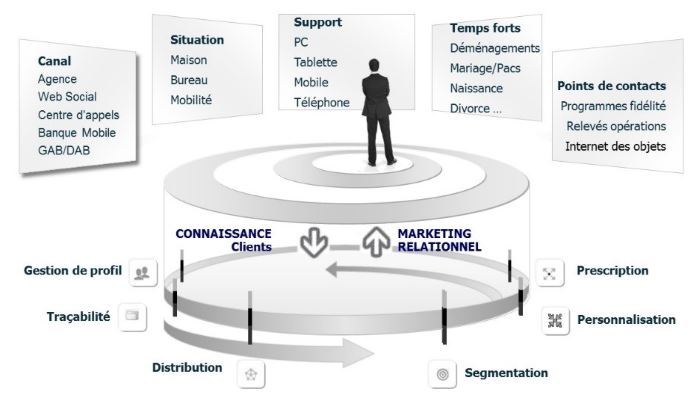These days, consumers have the upper hand when it comes to consuming advertising material. Marketing has fallen into its own trap of overflowing imagination. Artificial Intelligence may provide solutions and make it possible to go beyond mere analysis of the customer journey.
By multiplying the channels of communication, by using imagination to compete in developing new lines of communication to optimise the incentive to consume, marketing professionals find themselves faced by a paradox: how to assess the actual contribution that each channel makes to the success of a marketing activity? How should the overlapping interactions which the consumer faces be assessed?
From CRM (Customer Relationship management) to VRM (Vendor Relationship Management)
Consumers have become channel hoppers, starting their days with tablet, tea and biscuits, continuing it with mobile advertising on the metro, then diving into PC, meeting and mobile, followed by lunch-newspaper-mobile, PC-meeting-mobile again, finishing off the day by slouching in front of tablet TV, PC, mobile.
Faced by this deluge of information, the question for marketers is how to take up a position and identify their request in the morning, re-target at midday, prod their memory in the mid-afternoon via social networking and then try to make the conversion in the evening by making them an offer that they can’t refuse, all while avoiding oversaturation.

From knowing clients to relational marketing © DR
Many companies also call themselves “customer-centric”, i.e. putting the customer at the heart of the business, when they conduct this global analysis, while simply forgetting that it is customers who put themselves at the heart of the business (see the Harvard VRM project and the impact of the European GDPR Regulation).
The current limits of customer journey analysis
So what does it matter, I hear you ask, whether it is the business that puts the customer at the heart of its organisation, or the customer does it herself? What is important is that she is there, in the central role! But no. This is the core of the paradigm shift which is under way right now.
Until now, for Marketing the customer has been an object for a type of study that I would characterise as “reactive”, in the sense that the actual interactions between the customer and the environment that characterises him are analysed blow by blow, with a timid projection that only goes as far as the next punch. He is subjected to various statistical analyses, for example to pigeonhole him into a classification in which he will stay for months or even years, or in an attempt to predict the future purchase of a new banking product, or to analyse his internet use.

Customer journey analysis © DR
Customers position themselves at the heart of the business
In an attempt to capitalise on this information and to give a systemic vision of this customer, in recent years the concept of the customer journey has been developed. This is an analysis via which we can assess the impact of many of the events that punctuate the life of this customer (receiving a promotional email, customer call to the call centre, purchase of a new product, competing commercial pressure, etc.) on the next event which might trigger a purchase.
This analysis is the first sign of an awareness that it is actually customers who themselves take a position at the heart of the business, analysing them on an individual basis rather than a global one as previously. Thus a comparison between two similar customer journeys, those of Mr Smith and Mr Jones, will make it possible to offer Mr Smith the product or products owned by Mr Jones which he has not yet acquired (“next best offer”/“next best action”). However the product recommendation will only be evaluated in a real-life situation and it is only after “the offer you can’t refuse” has been made to Mr Smith that it will be known whether or not he buys this product. We are still operating reactively.
Towards a proactive model for marketing simulations
So what would this proactive mode look like, that allows a new product to be tested in isolation while taking account of the complexity of interactions between consumers and their environment? Is it possible to assess the appetite for this product for different groups of customers or prospects without testing in the field? In her excellent 2006 article: “Mesure de la performance et optimisation d’opération de marketing viral on line par les réseaux de Pétri”[Measuring performance and optimising online viral marketing operations using Petri networks], Christine Ballague cites the limitations of traditional statistical approaches when applied to viral marketing and proposes an approach based on Petri networks to incorporate the complexity of word of mouth interactions in social networks for the promotion of a brand or product.
Her conclusion is this: “Petri networks make it possible to model complex systems by simplifying them using the decomposition of the phenomenon into various states and transitions. They facilitate better understanding of these complex systems and above all they can be used to optimise marketing activities”. The Petri networks thus open the way for Artificial Intelligence and Multi Agent Systems (MAS).
The way is open for Artificial Intelligence

© DR
These apply a collection of techniques, of designs permitting heterogenous software, software components named “agents”, to cooperate via complex modes of interaction. Multi-agent systems are leading to a new vision of computing, positioned as an extension to the concept of an object.
By emphasising interaction and individual satisfaction, they are not permitted “to think of the global in centralised form” as Jacques Ferber has it in his general outline of the MAS field. In an MAS, everything is distributed, divided: knowledge, control, skills, activity, planning, etc. As a result, MASes adapt well to complex open systems where it is difficult to describe everything beforehand.
Thus future lines for research should make it possible for marketing to enrich their approach to knowledge about the customer. A complex system to simulate their customer base would allow simulations of the enthusiasm for customer segments about new products.
These segments would be represented in concrete form by software agents, capable of selecting the product that would maximise their satisfaction, and hence its own purchasing potential. And this could be done before any real customers come face to face with the products.

















Comment (1)
Your email address is only used by Business & Decision, the controller, to process your request and to send any Business & Decision communication related to your request only. Learn more about managing your data and your rights.